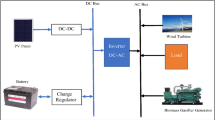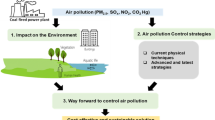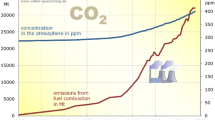Abstract
The atmospheric impact of stack emissions from a power plant (tri-generator and boilers) that will be installed in an urban area in the central Po valley (Northern Italy), characterized by calm wind events, is studied and compared with the impact of the existing plant (conventional boilers). Both the plants are supplied by methane gas. The atmospheric dispersion of NOx emitted is simulated, both in the current and future scenario, by the software package ARIA INDUSTRY. The NOx emission rates are set equal to the regulatory emission limits for existing and future boilers, while the tri-generation system emission rates are set equal to the emission limits certified by the system manufacturer. The simulation periods focus over the 2010 winter season. The simulation estimates the impact of NOx emissions on air quality (vertical concentration profiles and concentration maps at the ground) in the urban area close to the plant. The future power plant impact on air quality results lower than the impact of the existing plant, even if the yearly total mass of pollutants emitted in atmosphere from the new power plant is higher than from the existing plant. The emissions of conventional boilers result the main responsible of the air pollution at the ground in the future scenario.





Similar content being viewed by others
References
Anfossi D (1985) Analysis of plume rise data from five TVA steam plants. J Clim Appl Meteorol 24:1225–1236
Anfossi D, Bonino G, Bossa F, Richiardone R (1978) Plume rise from multiple sources: a new model. Atmos Environ 12:1821–1826
Anfossi D, Ferrero E, Brusasca G, Marzorati A, Tinarelli G (1993) A simple way of computing buoyant plume rise in a Lagrangian stochastic dispersion model. Atmos Environ 27A:1443–1445
Anfossi D, Ferrero E, Sacchetti D, Trini Castelli S (1997) Comparison among empirical probability density functions of the vertical velocity in the surface layer based on higher order correlations. Bound Layer Meteor 82:193–218
Armand P, Achim P, Commanay J, Chevallaz-Perrier R, Moussafir J, Moon D, Albergel A (2004) Mesoscale dispersion of xenon along the rhone valley in France: results of a modelling system chaining ADAS, MM5, MINERVE and SPRAY. Proc 9th Int Conf Harm Atmos Dispers Model Regul Purp 209–213
Bigi A, Ghermandi G, Harrison RM (2012) Analysis of the air pollution climate at a background site in the po valley. J Environ Monit 14:552
Breznik B, Božnar MZ, Mlakar P, Tinarelli G (2003) Dose projection using dispersion models. Int J Environ Pollut 20:278–285
Calori G, Clemente M, De Maria R, Finardi S, Lollobrigida F, Tinarelli G (2006) Air quality integrated modelling in Turin urban area. Environ Model Softw 21:468–476
Chandrasekar A, Philbrick CR, Clark R, Doddridge B, Georgopoulos P (2003) Evaluating the performance of a computationally efficient MM5/CALMET system for developing wind field inputs to air quality models. Atmos Environ 37:3267–3276
Cox RM, Sontowski J, Fry RN, Dougherty CM, Smith TJ (1998) Wind and diffusion modelling for complex terrain. J Appl Meteorol 37:996–1009
Cox RM, Sontowski J, Dougherty CM (2005) An evaluation of three diagnostic wind models (CALMET, MCSCIPUF, and SWIFT) with wind data from the Dipole Pride 26 field experiments. Meteorol Appl 12:329–341
Deserti M, Savoia E, Cacciamani C, Golinelli M, Kerschbaumer A, Leoncini G, Selvini A, Paccagnella T, Tibaldi S (2001) Operational meteorological pre-processing at Emilia Romagna ARPA meteorological service as a part of a decision support system for air quality management. Int J Environ Poll 16:571–582
Desiato F, Finardi S, Brusasca G, Morselli MG (1998) TRANSALP 1989 experimental campaign-I: simulation of 3D flow with diagnostic wind field models. Atmos Environ 32:1141–1156
Dharmadhikari S (1997) Consider tri-generation techniques for process plants. Hydrocarb Process 76:91–100
Du S (1997) Universality of the lagrangian velocity structure function constant (C0) across different kinds of turbulence. Bound Lay Meteorol 83:207–219
ENEL (2010) Rapporto ambientale ENEL 2010. ENEL http://www.enel.com/it-IT/doc/environmental_report/rapporto_ambientale_2010.pdf. Accessed 07 Jan 2013
E.U. (2004) Directive 2004/8/EC of the European Parliament and of the council of 11 February 2004 on the promotion of cogeneration based on a useful heat demand in the internal energy market and amending Directive 92/42/EEC. Official Journal of the European Union, L Serie, L52/50-L52/60
E.U. (2008) Directive 2008/50/EC of the European Parliament and of the Council of 21 May 2008 on ambient air quality and cleaner air for Europe. Official Journal of the European Union, L Series, L152/1-L152/144
E.U. (2009) Directive 2009/29/EC of the European Parliament and of the Council of 23 April 2009 amending Directive 2003/87/EC so as to improve and extend the greenhouse gas emission allowance trading scheme of the Community (Text with EEA relevance). Official Journal of the European Union, L Serie, L140/63-L 140/87
European Environmental Agency (2012a) Combined heat and power (CHP) (ENER 020) http://www.eea.europa.eu/data-and-maps/indicators/ds_resolveuid/49cd316cf53dbd23cf650127e47a0aac. Accessed 11 Mar 2013
European Environmental Agency (2012b) Energy efficiency in transformation (ENER 011) http://www.eea.europa.eu/data-and-maps/indicators/energy-efficiency-and-energy-consumption-5/ds_resolveuid/0a010911-6d85-46ed-b6ce-8b1550ebfbcd. Accessed 11 Mar 2013
Ferrero E, Anfossi D (1998) Comparison of PDFs, closures schemes and turbulence parameterizations in Lagrangian stochastic models. Int J Environ Poll 9:384–410
Ferrero E, Anfossi D, Tinarelli G (2001) Simulations of atmospheric dispersion in an Urban stable boundary layer. Int J Environ Poll 16:1–6
Ferrero L, Riccio A, Perrone MG, Sangiorgi G, Ferrini BS, Bolzacchini E (2011) Mixing height determination by tethered balloon-based particle soundings and modelling simulations. Atmos Res 102:145–156
Finardi S, Tinarelli G, Faggian P, Brusasca G (1998) Evaluation of different wind field modelling techniques for wind energy applications over complex topography. J Wind Engl Ind Aerod 74–76:283–294
Gariazzo C, Pelliccioni A, Bugliolo MP, Scalisi G (2004) Evaluation of a Lagrangian particle model (SPRAY) to assess environmental impact of an industrial facility in complex terrain. Water Air Soil Pollut 155:137–158
Gariazzo C, Papaleo V, Pelliccioni A, Calori G, Radice P, Tinarelli G (2007) Application of a Lagrangian particle model to assess the impact of harbour, industrial and urban activities on air quality in the Taranto area Italy. Atmos Environ 41(30):6432–6444
Geai P (1987) Methode d’interpolation et de reconstitution tridimensionelle d’un champ de vent: Le code d’analyse objective MINERVE. Report ARD-AID: E34-E11, EDF, Chatou, France
Ghermandi G, Teggi S, Fabbi S, Bigi A, Zaccanti MM (2011) Atmospheric impact of power plant stack emissions. Proc 14th Int Conf Harmon Atmos Dispers Model Regul Purp 240–244
Ghermandi G, Teggi S, Fabbi S, Bigi A, Cecchi R (2012) Model comparison in simulating the atmospheric dispersion of a pollutant plume in low wind conditions. Int J Environ Poll 48:69–77
Houghton JT, Ding Y, Griggs DJ, Noguer M, van der Linden PJ, Dai X, Maskell K, Johnson CA (2001) Climate change 2001: the scientific basis. Cambridge University Press, Cambridge
Jackson B, Chau D, Gurer K, Kaduwela A (2006) Comparison of ozone simulations using MM5 and CALMET/MM5 hybrid meteorological fields for the July/August 2000 CCOS episode. Atmos Environ 40(2812):2822
Levy JI, Spengler JD (2002) Modelling the benefits of power plant emission controls in massachusetts. J Air Waste Manag Assoc 52:5–18
Meunier F (2002) Co- and tri-generation contribution to climate change control. Appl Therm Eng 22(6):703–718
Pehnt M (2008) Environmental impacts of distributed energy systems: the case of micro cogeneration. Environ Sci Policy 11:25–37
Pernigotti D, Georgieva E, Thunis P, Bessagnet B (2012) Impact of meteorology on air quality modelling over the Po valley in northern Italy. Atmos Environ 51:303–310
Rodean HC (1995) Turbulent diffusion as a stochastic lagrangian process. Environmetrics 6:659–663. doi:10.1002/env.3170060613
Slawson PR, Csanady GT (1971) The effect of atmospheric conditions on plume rise. J Fluid Mech 47:33–49. doi:10.1017/S0022112071000910
Stull RB (1988) An introduction to boundary layer meteorology (Vol. 13). Springer
Thomson DJ (1987) Criteria for the selection of stochastic models of particle trajectories in the turbulent atmosphere. J Fluid Mech 180:529–556
Tinarelli G, Anfossi D, Bider M, Ferrero E, Trini Castelli S (1998) A new high performance version of the Lagrangian particle dispersion model SPRAY, some case studies. Proc 23rd CCMS-NATO Meeting, 499–507. Kluwer: Academic Publishers
Trini Castelli S, Anfossi D, Ferrero E (2002) Turbulence Statistics estimation and dispersion simulation scenarios in Urban environment, Proc 8th Int Conf Harmon Atmos Dispers Model Regul Purp 315–319
Trini Castelli S, Anfossi D, Ferrero E (2003) Evaluation of the environmental impact of two different heating scenarios in urban area. Int J Environ Poll 20:207–217
Tinarelli G, Anfossi D, Trini Castelli S, Bider M, Ferrero E (2000) A new high performance version of the lagrangian particle dispersion model Spray, Some Case Studies. In Air pollution modelling and its application XIII, Gryning, eds. Sven-Erik, Batchvarova, Ekaterina 499–507. US: Springer
Yim SHL, Fung JCH, Lau AKH, Kot SC (2007) Developing a high-resolution wind map for a complex terrain with a coupled MM5/CALMET system. J Geophys Res 112:D05106
Acknowledgments
The authors are thankful to the European Environment Agency for providing CORINE Land Cover 2000, to ARPA Emilia Romagna Weather Service for providing meteorological data, to ARPA Emilia Romagna for providing atmospheric pollutants concentration data and to USGS for providing SRTM DEM data.
Author information
Authors and Affiliations
Corresponding author
Rights and permissions
About this article
Cite this article
Ghermandi, G., Teggi, S., Fabbi, S. et al. Tri-generation power plant and conventional boilers: pollutant flow rate and atmospheric impact of stack emissions. Int. J. Environ. Sci. Technol. 12, 693–704 (2015). https://doi.org/10.1007/s13762-013-0463-1
Received:
Revised:
Accepted:
Published:
Issue Date:
DOI: https://doi.org/10.1007/s13762-013-0463-1




